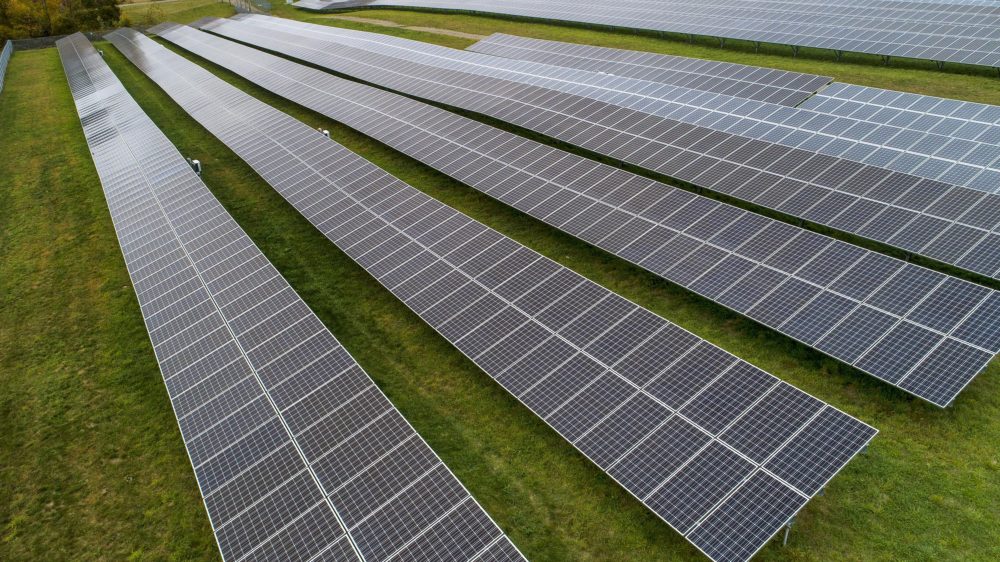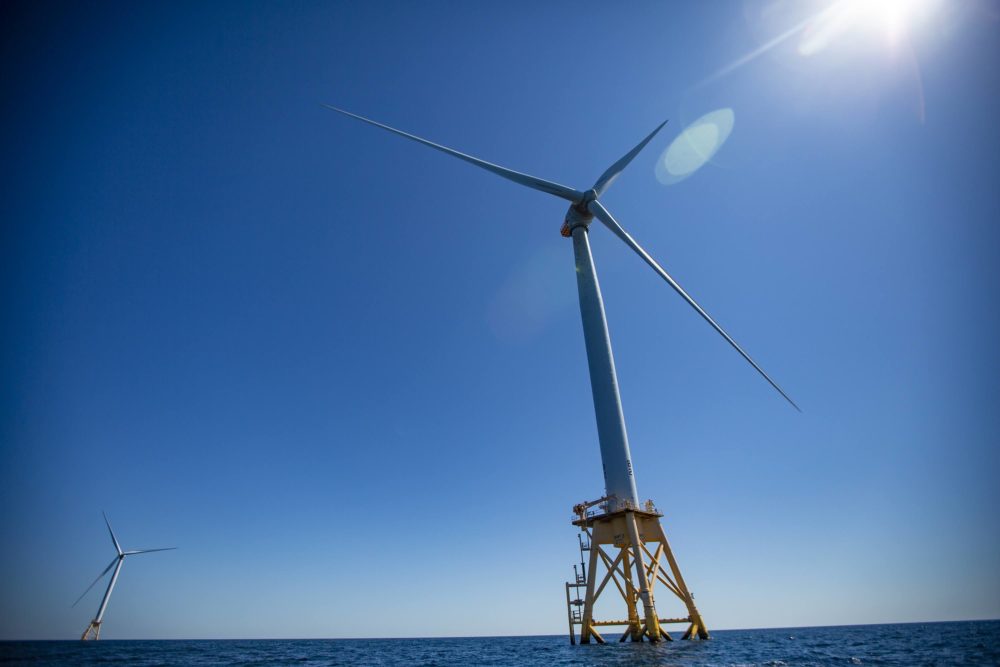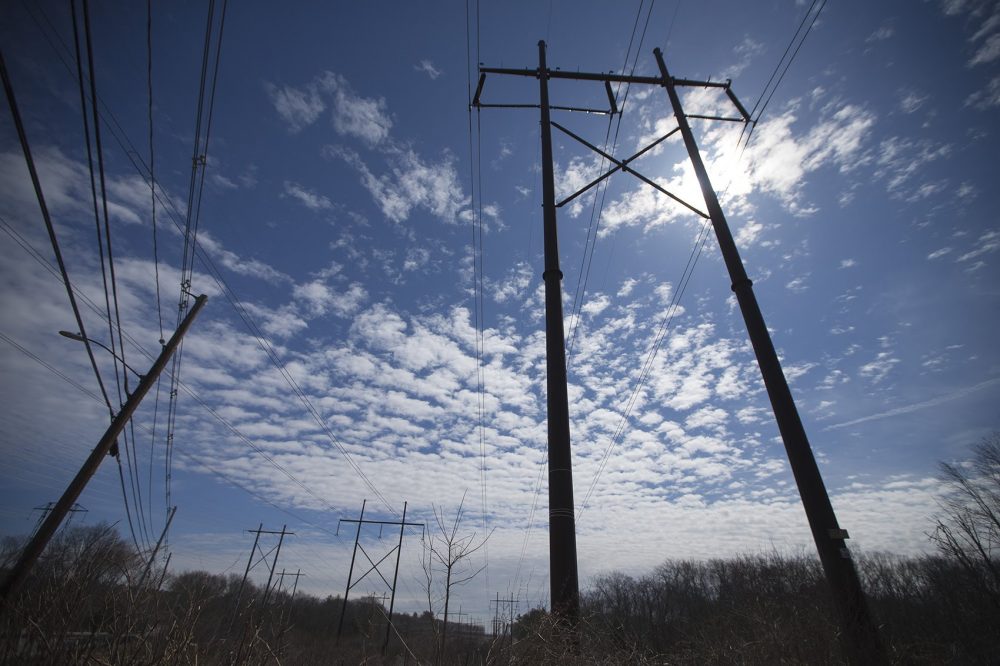The debate over an outdated rule that’s harming renewable energy in New England

The five turbines of the Block Island Wind Farm off the coast of Rhode Island. (Jesse Costa/WBUR)
There’s a rule in the New England energy system that nobody likes.
And not just because it uses a lot of complex math.
This rule ends up making it harder for renewable energy projects to participate in an important regional electricity market.
The New England states want it gone.
U.S. Senators Ed Markey, Elizabeth Warren and Bernie Sanders want it gone.
The feds, who told New England to adopt the rule in 2013, want it gone.
Even ISO New England, the grid operator that designed the rule, agrees it needs to go.
But it’s still here, and might not go away until 2025.
Why?
Welcome to the world of the Minimum Offer Price Rule, or MOPR (pronounced MOPE-er), a complicated pricing formula that critics say is harming the ability of New England states to meet their climate goals and making your monthly electricity bill higher.
While most agree the system needs to change, there are competing views about how to do it. Earlier this year, the grid operator proposed one solution. Some saw it as a compromise, others said it was a concession to fossil fuel plant owners.
This all gets very technical very quickly. But with federal regulators set to rule on the proposal by the end of the month, here is what you need to know:
What is the MOPR?
In New England, much of the energy market works as you might imagine: a power plant or solar farm creates electricity and then gets paid for sending it to the grid. End of story.
Except not really.
The grid operator also runs a separate market that pays energy producers to be “on call” in the future. With this market, the grid operator can make sure that the region will have enough power when demand spikes on hot summer afternoons or cold winter days, and project owners can secure money to help finance new facilities. (Texas doesn’t have a forward market like this, which was part of the reason electricity prices went through the roof during last winter’s cold snap.)
In New England, the grid operator holds an annual auction for the “on-call” market to lock in the capacity it thinks the region will need three years in the future. For example, the power generators that won a spot in this year’s auction are on stand-by beginning June 1, 2025.
About 15 years ago, federal energy regulators spotted a problem in a neighboring region with a similar futures market. There wasn’t enough capacity being bid into the market, so the auction price was high. This was good for power plant owners, but not so great for ratepayers who had to pay more on their monthly electric bills.
Some politicians decided to “solve” the problem by subsidizing a bunch of new natural gas plants that normally wouldn’t have been economical to build. Those plants flooded the market with cheap auction bids, which helped lower prices, but the whole scheme was deemed anti-competitive.
As a result, the feds ordered the three regions with similar on-call energy markets, including New England, to establish MOPRs — rules about the minimum price new power generators could offer at the auction. (Once a project gets into the on-call market, it can bid whatever it wants in subsequent years because the MOPR no longer applies.)

Solar panels in a field at Knowlton Farm, Grafton, Mass. (Robin Lubbock/WBUR)
How does the MOPR work?
Let’s pretend it’s auction time and that we have three new power generation sources trying to get into the capacity market: Natural Gas Plant A, Solar Farm B and Offshore Wind Farm C. They each place a bid with a price they think is low enough to be accepted but high enough to cover their costs.
Once those bids are submitted, the grid operator determines the “clearing price.” In golfing terms, this is par. If you come in above par, you lose. In our example, if the auction clearing price was $3 per kilowatt-month, and Project A bid $4, it wouldn’t get a spot in the capacity market. If Project B bid $2 it would get in, and it would get paid at the clearing price.
The MOPR adds a layer of complexity by dictating the lowest possible price that the owners of these projects can bid at the auction. Back to golf: MOPR can add strokes to your score, meaning it’s harder for you to make par.
For solar projects in this most recent auction cycle, the price floor was $0, meaning it wouldn’t have affected Plant B’s bid. For natural gas plants, however, the price floor was between $5-$9, depending on the type of facility, and for offshore wind it was over $12.
In this scenario, the MOPR prevented the new natural gas plant and the new offshore wind farm from bidding with a price that will clear the auction.
So game over? Not quite.
A project that’s stymied by the MOPR can make a case to the grid operator about why it should be allowed to bid at a lower price. These discussions are confidential, but given that several new gas plants have gotten into the capacity market in recent years, it’s clear that their attempts worked.
Offshore wind has not been as successful. Vineyard Wind, the first U.S. commercial-scale offshore wind farm being built near Martha’s Vineyard, challenged the MOPR price this year and was denied. As a result, the project didn’t clear the auction.

Two turbines of the Block Island Wind Farm off the coast of Rhode Island. (Jesse Costa/WBUR)
How is the MOPR calculated?
The MOPR is supposed to reflect the amount of money a new project needs to make in the on-call capacity market to be financially viable. To arrive at that number, the grid operator considers the cost of building the project, the amount of money the facility can expect to receive in the real-time energy market and any other sources of revenue it might have.
The problem is, not all forms of revenue count as “legitimate.”
To use a real world example, Massachusetts has laws requiring that utilities buy a certain amount of power from offshore wind projects every year. But those state-sponsored power purchase agreements don’t “count” in the MOPR world, so the grid operator’s math assumes that an offshore wind farm like Vineyard Wind needs to make a lot more money from the on-call market than it really does.
“States like Massachusetts are passing laws to create incentives [for renewables] not to manipulate the market price, but to address climate change and create other economic benefits,” said Bruce Ho, deputy director of the Natural Resources Defense Council’s Climate and Clean Energy Program. “And these policies are getting caught in the MOPR trap.”
So far, the MOPR has presented the biggest problem for offshore wind since the minimum prices for onshore wind, solar and battery storage have been quite low in recent years.
That’s not to say offshore wind hasn’t gotten any capacity into the market. It has, but by other means. Specifically, through a program called the Competitive Auctions with Sponsored Policy Resources, or CASPR (just like the friendly ghost!) More on this later.
Why people want to scrap the MOPR
Simply put, MOPR critics say the rule is bad for the environment and bad for ratepayers.
They say it’s bad for the environment because by making it harder for renewable energy projects to get into the market, the MOPR props up older, often-dirtier fossil fuel plants.
And they say it’s bad for ratepayers because if new, cheaper renewables were able to participate in the on-call market, the clearing price could be lower, and thus, so would electricity bills.
There’s also concern that keeping the MOPR in place will force ratepayers to pay for more capacity than the system needs. Think about it like this: renewable energy projects with state-sponsored electricity contracts like Vineyard Wind are going to get built whether or not they can participate in the on-call market. But since the grid operator isn’t factoring their ability to create electricity into its three-year planning, the region could end up with excess capacity. And that means higher-than-necessary electricity bills.

The coal-fired Merrimack Station in Bow, New Hampshire. (Annie Ropeik/NHPR)
So does anyone like the MOPR?
The operators of some older fossil fuel plants are in favor of keeping it. But for the most part, politicians, environmentalists and others in the New England energy world say that it isn’t compatible with the states’ clean energy plans.
The chairman of the Federal Energy Regulatory Commission, Richard Glick, recently called New England’s MOPR “the antithesis of market competition” and said it serves “only to prop up capacity prices, protect incumbent generators, and increase the costs of state policies.”
So yeah, the MOPR is not very popular.
Then why do we still have it?
Well, we won’t have it forever.
Beginning last summer, the grid operator held nine months of stakeholder meetings to discuss getting rid of the MOPR. According to some who were in those meetings, the momentum was for scrapping the rule right away. But then, at the last minute, the grid operator announced it had decided to support a plan first proposed by a few energy companies that would keep the MOPR in place until 2025.
While 61% of its stakeholders eventually went along with the plan, ISO New England’s decision to support it did not go over well with many in the region.
A federal filing from the attorneys general of Massachusetts and Maine called it “a complete surprise” and accused the grid operator of citing “a number of negative consequences” without evaluating how likely (or not) they were to happen, or how the compromise would solve these problems.
Others who oppose the proposal call it a cynical attempt to avoid litigation by incumbent power generators, many of whom have said they would sue if the MOPR was eliminated immediately.
Why the change of heart?
Matt Kakley, a spokesperson for ISO New England, rejected the idea that this was some sort of last minute flip flop.
“When we enter a stakeholder process, it’s a stakeholder process. We take feedback, we listen to people, we listen to ideas and things change based on that feedback,” he said. “It was a compromise proposal, and it gave us a clear line of when the MOPR would be gone.”
Those in favor of the delay proposal say it will do two things:
1. Maintain grid reliability: Those who support the delay argue that, in a world without the MOPR, a flood of new offshore wind projects could bid low in the auction and compel older fossil fuel plants to retire early. If these wind farms, which haven’t been built yet, run into regulatory or construction issues that cause them to be delayed, New England could have trouble generating enough power during high demand times.
Those who don’t want to delay MOPR elimination say that’s scaremongering.
“State procurements for clean energy resources are like the most transparent processes possible. We know every offshore wind project that has been procured,” said Abigail Krich, an energy market expert and president of Boreas Renewables. “So this idea that it’s unknowable, like if we just open the floodgates, we have no idea how much offshore wind will come into the market, is completely false.”
2. Buy time for other reforms: ISO New England is constantly updating its market rules and procedures, and those who want to delay eliminating the MOPR say that an extra few years will give the grid operator more time to finish a few separate, but related market reforms.
Kirch calls that a bad faith argument. Offshore wind developers aren’t actually prohibited from getting their capacity into the market over the next two years — they just have to pay extra to do so.

Powerlines in Medway, Mass. (Jesse Costa/WBUR)
What’s in the transition proposal?
In addition to the two-year delay, the proposal does a few other things.
- It allows a small amount of clean energy to bid into the market without the MOPR price. Up to 300 megawatts of renewables can do this in 2023 auction, and 400 megawatts the following year. These 700 megawatts represent about 2% of the total on-call power in the market.
- It puts into place new, more targeted rules to prevent the type of market manipulation MOPR was originally designed to prevent.
- It eliminates the price ceiling in the CASPR program.
Designed as a sort of “Cash for Clunkers” for the energy market, CASPR lets older plants that want to permanently shut down sell their existing on-call obligations to renewable projects that can’t get into the market because of the MOPR. In order to prevent plants from getting unfairly high payouts as they retire, the grid operator sets a maximum price that the plant can change.
Under the transition plan, CASPR goes away when the MOPR goes away, and at that point, plants won’t get any money for retiring. So critics contend that eliminating the price cap is hypocritical because it incentivizes older plants to retire, the very thing the delay proposal was designed to prevent.
What happens now?
ISO New England formally submitted its transition plan to the Federal Energy Regulatory Commission in March and the body has until May 31 to rule on it.
While they could approve it, deny it, or send it back with suggestions, only one thing is certain: whatever decision they make will leave some segment of New England unhappy.
This story was originally published on WBUR.org, a partner of the New England News Collaborative.
